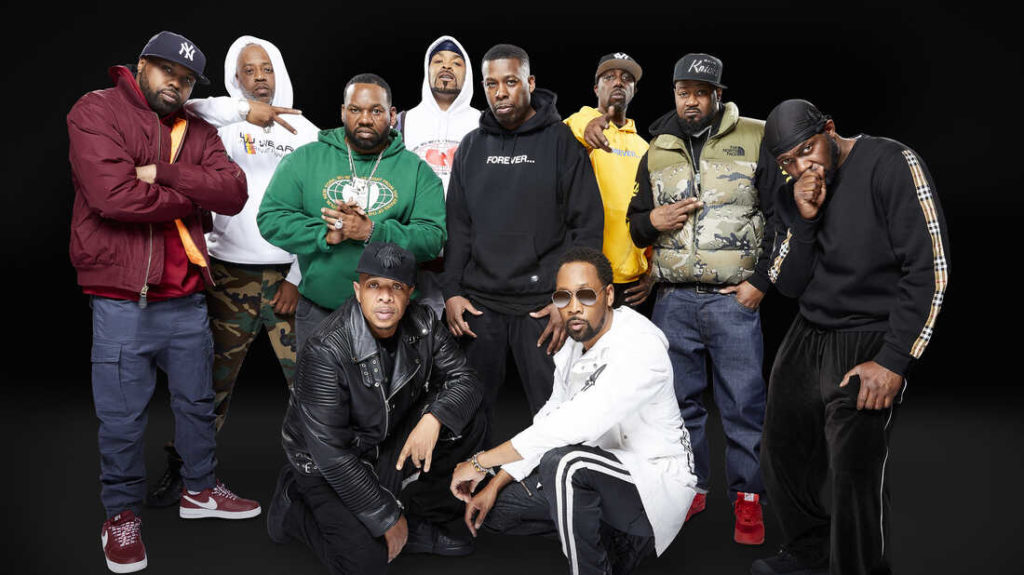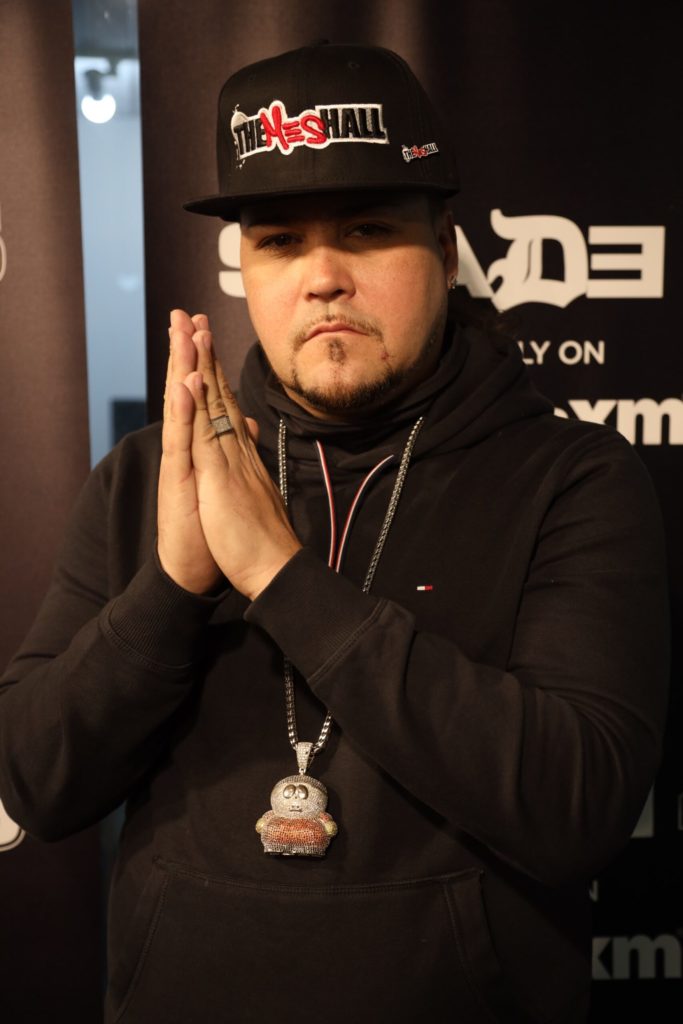“Wu-Tang: An American Saga” Shows The Full Story
Written by Live 89FM on April 10, 2023
Since art often imitates life, it’s fitting that the show’s third and final season — available now on Hulu — turned those three albums into mini-movies within the season’s overall story. Instead of transforming those moments into Wikipedia entries that checked boxes with stories that read “true,” Wu-Tang: An American Saga went allegorical in its recreations and revealed more about the artists and the group than a conventional biopic.
Rather than stick to the formula seen in countless onscreen music projects where an artist steps in the booth and makes music, the Season Three episodes titled Dirty Dancin, Criminology, and Liquid Swords portray real life through fantasy. Those three episodes showed audiences what Ol’ Dirty Bastard, Raekwon and Ghostface Killah, and GZA hoped their respective albums might achieve, along with conveying the influences embedded in their music.

Wu-Tang Clan
The aforementioned episodes represent four distinct people with, at times, different outlooks on hip-hop and even the recording process. According to the show, and real life, Ol’ Dirty Bastard clashed with schedules. He hated constrictions and wanted a unique album that lived up to his namesake, because as he explained on the group’s debut, there was no father to his style. Raekwon and Ghost wrote Only Built 4 Cuban Linx in the Bahamas and Miami while watching movies such as The Killer, A Better Tomorrow, The Godfather, and Scarface for inspiration. GZA, who released his first album in 1991, had a chip on his shoulder that probably felt more like a boulder after dealing with record label politics in the late 1980s and early 1990s. He had “certain things to prove” with Liquid Swords and dropped knowledge so that other artists might avoid the same pitfalls he fell into early in his career.
Wu-Tang: An American Saga makes those separate journeys visually exciting and moves the more significant story forward without sacrificing anything the audience knows about the characters on the show or their real-life counterparts. How? The show kept things simple and went back to the music. “We did up-to-date, enhanced versions of those movies because Cuban Linx is a movie,” said RZA. “Same thing with Liquid Swords.”
GZA and RZA created Liquid Swords as a Japanese samurai movie. Using the film Shogun Assassin as the framing device, GZA’s 1995 album cast the Genius as “the greatest samurai in the empire” famous for his sword techniques and the hundreds of severed heads left in his wake. Liquid Swords took GZA on a journey from Brooklyn to Staten Island. He observed atrocities, educated everyone in his path, and put lyrical ability above everything else.
The episode that shares the album’s title tells a similar tale but mines more emotion and gives more insight into GZA’s (Johnell Young) perspective at the time. He’s still the samurai with the sharpest sword in all the land but said land is in trouble: Hip-hop was corrupted by commercialization, promising rappers all the spoils from recording for a mainstream label that barely understands the music.
On the show, the culture vulture behavior turns this fantasy New York City into a desolate wasteland that only GZA and the rest of the Wu-Tang Clan can save. There’s even a clever nod to Mariah Carey and Ol’ Dirty Bastard’s “Fantasy” duet that sheds light on how GZA felt about similar crossover attempts and plays an integral part in the episode’s plot. Liquid Swords distills GZA’s feelings about record labels, dumbed-down lyrics, chasing radio airplay, and the violence in his community into an hourlong drama with an arc for its main character. It also seamlessly integrates several album cuts for dramatic effect. There’s an apparent reason GZA, Masta Killa (JaQwan J. Kelly), Inspectah Deck (Uyoata Udi), and Ol’ Dirty Bastard (TJ Atoms) perform “Duel of the Iron Mic” when they do, and it serves the overall narrative.
That last part isn’t easy. Criminology ditches the musical device altogether. Rather than showing Raekwon (Shameik Moore) or Ghostface Killah (Siddiq Saunderson) perform songs in character, the episode opts for the real-life versions as diegetic or non-diegetic music based on the scene. GZA is still GZA in his episode, but Raekwon and Ghostface Killah are Lex Diamond and Tony Stark, respectively; they’re mobsters, not rappers. That tailored approach grants Criminology more creative freedom by incorporating ideas from Only Built 4 Cuban Linx without directly copying the album’s narrative.
It’s less about two drug dealers pulling one last job before they leave the game and more about two guys who want to rule New York’s underworld. Exchange “hip-hop scene” for “underworld,” and that’s how Raekwon and Ghostface Killah felt in 1995. They make their feelings about their competition, their friends, and their foes clear as crystal during a Cuban Linx interlude, which the episode turns into a significant plot point.
Wu-Tang: An American Saga establishes why Raekwon and Ghostface Killah made their music, not how they made it. Criminology shows how they felt about each other and how they saw the rest of the Clan fitting into this “Wu Gambino ” lifestyle they envisioned. Only Built 4 Cuban Linx is different from any Wu-Tang Clan album that came before or after it, so even the episode looks different. It’s more polished than Dirty Dancin. And unlike Liquid Swords, it plants itself firmly in reality.
Raekwon and Ghostface Killah’s dedicated hour of TV is violent, mysterious, and sparingly tickles its funny bone for a laugh. Ol’ Dirty Bastard’s story is a blaxploitation flick that rarely takes itself seriously. GZA’s tale plays it straight but never shies away from its larger-than-life concept and all that entails. But this mob movie stays in line with an album that Raekwon said “was almost like a tablet of my life, where I wanted to go and all the s— I seen.”
Sadly, real life robbed us of any similar insights from Ol’ Dirty Bastard, who died in 2004. But his collaborator, RZA, understood his cousin and ensured Dirty Dancin reflected Ol’ Dirty Bastard’s creative influences such as Soul Train, kung fu flicks, ’70s soul music, and comedy. “His album gives you the reality and then gives you a comedic spin on it. It’s like a musical Richard Pryor album,” said RZA. With that in mind, the episode reimagines Ol’ Dirty Bastard as a raunchy, uncontrollable comedian in the 1970s who idolized Soul Train host Don Cornelius.
RZA (Ashton Sanders) plays the club promoter charged with harnessing Ol’ Dirty Bastard’s chaotic energy into something palpable for the audiences who showed up every night. Criminology and Liquid Swords keep their influences pretty straightforward. But Dirty Dancin, like the blaxploitation movies it imitates, throws several cultural touchstones that affect Ol’ Dirty Bastard into a pot and creates gumbo.
But it also shows how much his community made him into the person and rapper he became. Ol’ Dirty Bastard’s cousin and former manager, Divine, noted that he always told his fellow Clan members to “rap about the truth.” Fittingly, the episode’s narrative hides an insidious truth at its center related to messaging aimed at the Black community. Revealing said truth and saving the people in the process falls on Ol’ Dirty Bastard’s shoulders in comedic fashion. But the laughs take nothing away from the episode’s underlying seriousness. As RZA said, that was his genius.
Mythology and the Wu-Tang Clan go hand in hand. Just look at their name. Their music evokes cinema through stories about everyday people and situations that take on more significant meanings when added to their narrative. They have slang and inside references and position their albums as more than just music by using clips from kung fu movies as framing devices. Wu-Tang: An American Saga takes all that one step further with these three episodes and finds the artists’ truth.
Sure, scenes with GZA, Raekwon, Ghostface Killah, and Ol’ Dirty Bastard explaining how they feel about corporations taking over hip-hop, or why they approached the rap game like street hustlers, or giving voice to the fact that the conventional rap album construct hinders their creative juices might work.
But showing all of that through the visual medium makes it memorable. The episodes give the audience a glimpse of life from Wu-Tang Clan members’ perspectives and show us how they feel rather than simply telling us.
Which, when put into context, is precisely what any good solo album should do.








